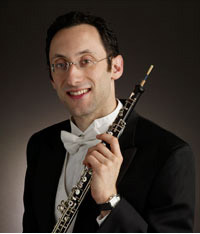by Jarrett Hoffman

And then, suddenly, the composer had. His Oboe Concerto would be premiered just months later in Zürich. And what a concerto it was — and is. As Cleveland Orchestra principal oboe Frank Rosenwein (above) told me during a recent phone call, “it stands at the pinnacle of oboe writing in terms of its beauty, but also its difficulty.”
Rosenwein will play the Strauss Concerto with CityMusic Cleveland and principal guest conductor Stefan Willich in five free performances this week. As is the orchestra’s custom, the concerts will jump from venue to venue each day from Wednesday, December 12 through Sunday, December 16 (details below).
“The concept of free concerts all over the Cleveland area is something that I can really get behind,” Rosenwein said. “I’m happy to bring this music to people who wouldn’t necessarily hear it in Severance Hall.”
The Concerto is already known for being, well, really hard. Playing it five nights in a row will just be the cherry on top — a two-pronged challenge between having “the specialized reed that the piece needs, and then the stamina,” Rosenwein said. “I’m looking forward to climbing that mountain.”
I told Rosenwein that I’ve heard oboists call the piece much harder than it sounds. “Right,” he said, “it should not sound difficult, it should sound very tossed off.” He laughed. “Easier said than done.”
What makes it so difficult? For one, its melodic lines that Rosenwein described as unending. “Strauss bases this concerto on Classical and Romantic concepts,” he said. “But it really has a late Romantic style of phrasing that’s sort of generative — you reach a height, and then you keep going, and then you go even further. There’s a certain Wagnerian sense to it. So there’s a real difficulty in having to play for so long without a break, which happens over large stretches both in the first and second movements.”
Another demand for the player: a high degree of control across the entire range of the instrument, and throughout the dynamic spectrum. “It requires the oboist to have a lot of oomph in the sound — a lot of ‘go,’ a lot of presence,” Rosenwein said. “And at the same time, it’s really intimate and requires the most refined kinds of sounds you can make.”
Next I asked about the minute-and-a-half cadenza that connects the second and third movements. “It’s a structured cadenza,” he said, “in that the orchestra pokes in at various times as if to say, ‘Yes!’ or ‘Really?’ There’s a commentary happening, and depending on how the orchestra plays it, it sends the cadenza off in different directions.”
And while the cadenza is certainly florid, Rosenwein also called it “a meditation on the gentle nature of the second movement, and then a transition to the joyousness of the last movement.”

Left to right: John de Lancie, Richard Strauss, Marcel Tabuteau
Jumping back to the story of John de Lancie and Strauss, I asked Rosenwein about an awkward moment in the Concerto’s history. When the time came to arrange the U.S. premiere, Strauss wanted de Lancie to have the honor. But the oboist had recently joined the Philadelphia Orchestra as assistant principal — and the famed principal, Marcel Tabuteau, wasn’t about to let that happen. The American premiere ended up going to a friend of de Lancie’s, Mitch Miller of the CBS Symphony.
“I mean, I get it — orchestras are hierarchical,” Rosenwein said. “But that’s an interesting wrinkle that Tabuteau didn’t play it. I think I would have said, ‘Excellent, my young underling, I’ll take that!’” He laughed. “I mean, it’s difficult and it’s long, but wow — what an important piece for oboists.”
In addition to the Strauss, the program includes the Overture to Rossini’s L’italiana in Algeri and Mozart’s Symphony No. 39 in E. The five performances take place on Wednesday, December 12 (7:30 pm at St. Jerome Church in Collinwood), Thursday the 13th (7:30 pm at Temple Tifereth-Israel in Beachwood), Friday the 14th (7:30 pm at Lakewood Congregational Church), Saturday the 15th (8:00 pm at Shrine Church of St. Stanislaus in Slavic Village), and Sunday the 16th (4:00 pm at St. Noel Church in Willoughby Hills).
Cleveland Orchestra photo of Rosenwein by Roger Mastroianni.
Published on ClevelandClassical.com December 10, 2018.
Click here for a printable copy of this article



